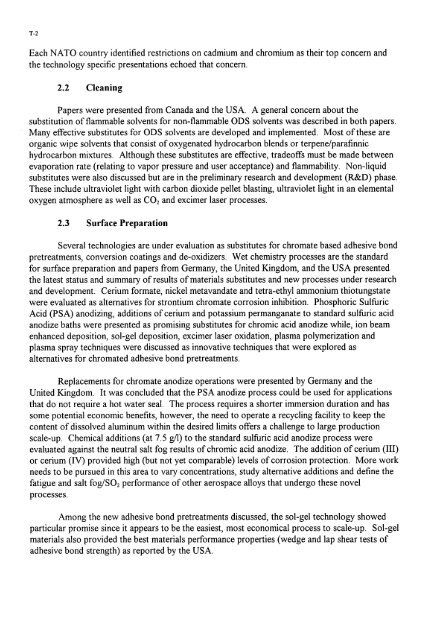Available - NATO Research & Technology Organisation
Available - NATO Research & Technology Organisation
Available - NATO Research & Technology Organisation
You also want an ePaper? Increase the reach of your titles
YUMPU automatically turns print PDFs into web optimized ePapers that Google loves.
T-2<br />
Each <strong>NATO</strong> country identified restrictions on cadmium and chromium as their top concern and<br />
the technology specific presentations echoed that concern.<br />
2.2 Cleaning<br />
Papers were presented from Canada and the USA. A general concern about the<br />
substitution of flammable solvents for non-flammable ODS solvents was described in both papers.<br />
Many effective substitutes for ODS solvents are developed and implemented. Most of these are<br />
organic wipe solvents that consist of oxygenated hydrocarbon blends or terpene/parafinnic<br />
hydrocarbon mixtures. Although these substitutes are effective, tradeoffs must be made between<br />
evaporation rate (relating to vapor pressure and user acceptance) and flammability. Non-liquid<br />
substitutes were also discussed but are in the preliminary research and development (R&D) phase.<br />
These include ultraviolet light with carbon dioxide pellet blasting, ultraviolet light in an elemental<br />
oxygen atmosphere as well as CO, and excimer laser processes.<br />
2.3 Surface Preparation<br />
Several technologies are under evaluation as substitutes for chromate based adhesive bond<br />
pretreatments, conversion coatings and de-oxidizers. Wet chemistry processes are the standard<br />
for surface preparation and papers from Germany, the United Kingdom, and the USA presented<br />
the latest status and summary of results of materials substitutes and new processes under research<br />
and development. Cerium formate, nickel metavandate and tetra-ethyl ammonium thiotungstate<br />
were evaluated as alternatives for strontium chromate corrosion inhibition. Phosphoric Sulfuric<br />
Acid (PSA) anodizing, additions of cerium and potassium permanganate to standard sulfuric acid<br />
anodize baths were presented as promising substitutes for chromic acid anodize while, ion beam<br />
enhanced deposition, sol-gel deposition, excimer laser oxidation, plasma polymerization and<br />
plasma spray techniques were discussed as innovative techniques that were explored as<br />
alternatives for chromated adhesive bond pretreatments.<br />
Replacements for chromate anodize operations were presented by Germany and the<br />
United Kingdom. It was concluded that the PSA anodize process could be used for applications<br />
that do not require a hot water seal. The process requires a shorter immersion duration and has<br />
some potential economic benefits, however, the need to operate a recycling facility to keep the<br />
content of dissolved aluminum within the desired limits offers a challenge to large production<br />
scale-up. Chemical additions (at 7.5 g/l) to the standard sulfuric acid anodize process were<br />
evaluated against the neutral salt fog results of chromic acid anodize. The addition of cerium (111)<br />
or cerium (IV) provided high (but not yet comparable) levels of corrosion protection. More work<br />
needs to be pursued in this area to vary concentrations, study alternative additions and define the<br />
fatigue and salt fog/SO, performance of other aerospace alloys that undergo these novel<br />
processes.<br />
Among the new adhesive bond pretreatments discussed, the sol-gel technology showed<br />
particular promise since it appears to be the easiest, most economical process to scale-up. Sol-gel<br />
materials also provided the best materials performance properties (wedge and lap shear tests of<br />
adhesive bond strength) as reported by the USA.
















